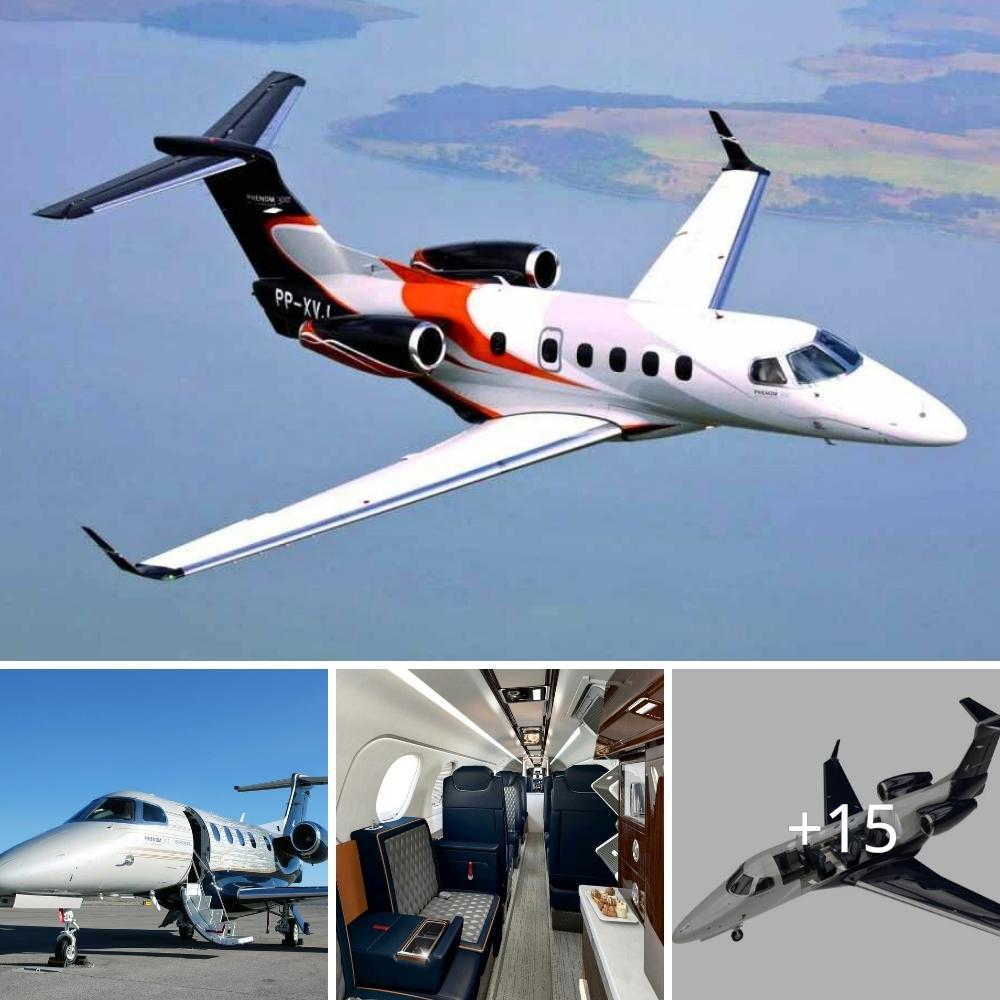Often referred to as the ‘Bug’ and ‘Super Bug’, Boeing’s F/A-18 Hornet and Super Hornet strike fighters are the tactical workhorses of US naval aviation.
They are assigned to 34 operational naval squadrons, and each carrier air wing typically deploys with around 40 of the strike fighters. The single- and two-seat versions of the ‘legacy’ or ‘classic’ Hornet are also flown by 11 operational US Marine Corps (USMC) squadrons.
Since 1978, 1,049 production Hornets and 570 Super Hornets have been supplied to the navy and marines – 371 F/A-18As and 39 F/A-18Bs, 476 F/A-18Cs and 163 F/A-18Ds, 297 F/A-18Es and 273 F/A-18Fs. Additionally, 11 F/A-18As, two F/A-18Bs (originally F-18As and TF-18As), five F/A-18Es and two F/A- 18Fs were delivered under developmental programmes.
Developed by McDonnell Douglas and Northrop (now Boeing and Northrop Grumman), the Hornet was conceived in response to a US Navy (USN) requirement for a multi-role fighter/attack aircraft (VFAX). The prototype first flew on November 18, 1978, and the F/A-18A entered service in February 1981, becoming operational in 1983 and first seeing combat over Libya in 1986.
The single-seat F/A-18C and two-seat F/A-18D were the result of a block upgrade programme that initially provided new computers, the AN/ALQ-165 airborne self-protection jammer (ASPJ) and provisions for carrying the AIM-120, AGM-65 and AGM-84 missiles with more upgrades subsequently added. The F/A-18C/D entered production in 1987 and a night attack capability was incorporated beginning with Lot 12 production aircraft.
Unlike the USN, which limited its two-seat Hornets to the training role, the USMC put 96 F/A-18Ds into operational service with six all-weather fighter attack squadrons. The aircraft were assigned to numerous roles, including air interdiction (AI), suppression of enemy air defences (SEAD), close air support (CAS), forward air control (FAC) and tactical reconnaissance. Although the F/A-18Ds can be returned to trainer configuration, the rudder pedals are disconnected and the aft cockpit control sticks and throttle quadrants are replaced by a pair of side-mounted hand controls units (HCUs) used by the weapons system officer (WSO) to operate the armament controls. Weapons cannot be launched/released from the rear cockpit of the two-seat trainers, though can be from the USMC F/A-18Ds.
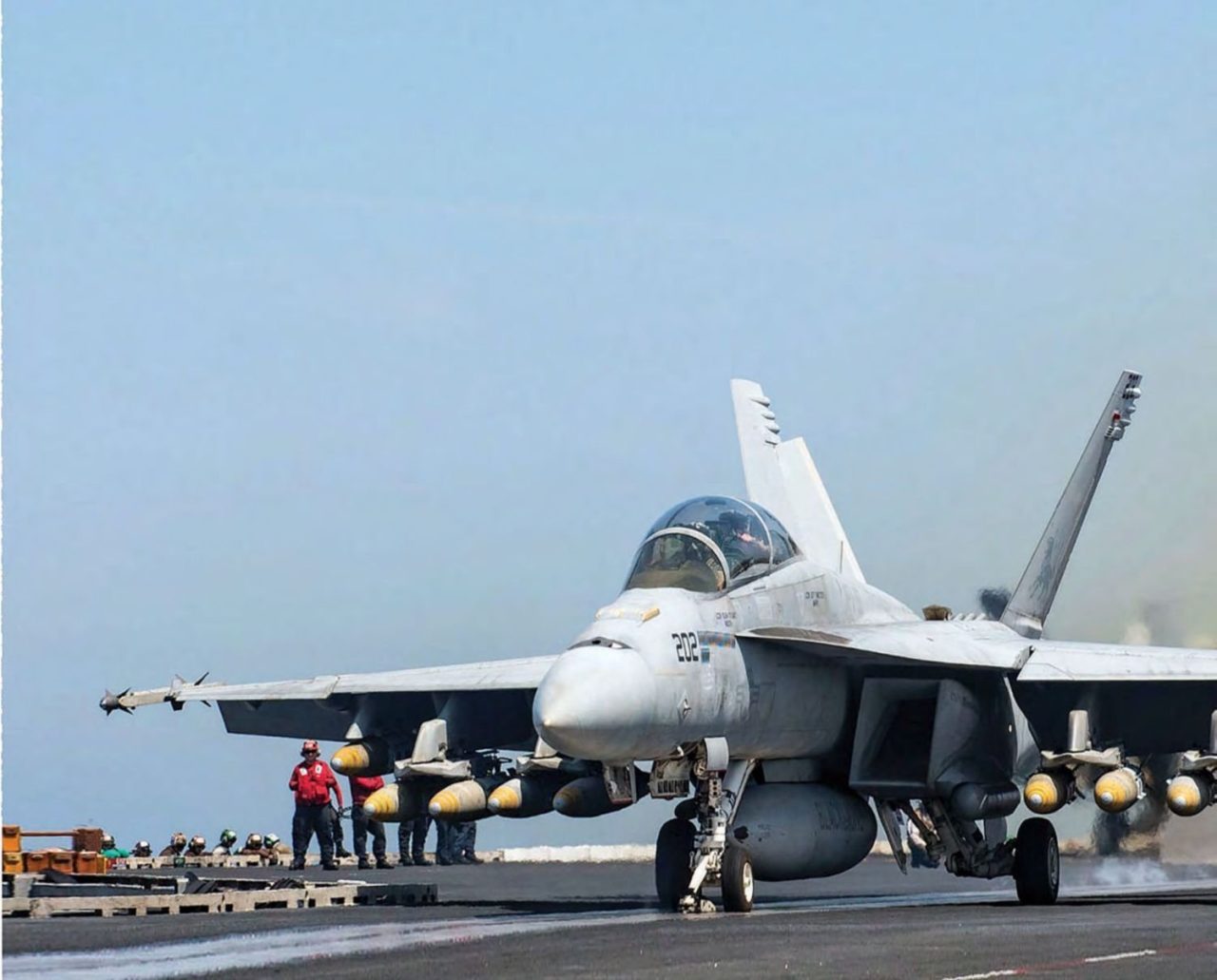 A VFA-213 ‘Black Lions’ F/A-18F in the process of being launched from the aircraft carrier USS George H W Bush.US Navy/MC3 Matt Matlage
A VFA-213 ‘Black Lions’ F/A-18F in the process of being launched from the aircraft carrier USS George H W Bush.US Navy/MC3 Matt Matlage  A Hornet assigned to VFA-37 is readied on a USS George H W Bush waist catapult. The ‘Ragin’ Bulls’ are one of four Atlantic Fleet squadrons that continues to operate the F/A- 18C.US Navy/MC3 Christopher Gaines
A Hornet assigned to VFA-37 is readied on a USS George H W Bush waist catapult. The ‘Ragin’ Bulls’ are one of four Atlantic Fleet squadrons that continues to operate the F/A- 18C.US Navy/MC3 Christopher Gaines
The US Navy first considered an advanced, more capable version of the strike fighter as part of the Hornet 2000 study, which began in May 1987, and formal development of the Super Hornet began five years later in May 1992.
The F/A-18E first flew on November 29, 1995 and the two-seat ‘F’ model followed on April 1 the next year. Deliveries of both variants began in September 1999. The Super Hornet achieved initial operational capability (IOC) in 2001 and began its first deployment in July 2002. The fighter’s combat debut followed when VFA-115 flew strikes in Afghanistan as part of Operation Enduring Freedom four months later.
Boeing delivered 147 Block I Super Hornets – 64 F/A-18Es and 83 F/A- 18Fs – before production switched to the Block II variant in Lot 26. Whereas Block I variants retained the F/A- 18C’s Hughes (now Raytheon) AN/ APG-73 radar, the forward fuselage of the Block II – first delivered in October 2002 – was redesigned to accommodate a new active electronically scanned array (AESA) radar.
Although similar in configuration, the Hornet and Super Hornet are essentially different aircraft and share few structural components. At 60.3ft (18.38m), the F/A- 18E’s fuselage is 4.3ft (1.31m) longer than the F/A-18C’s and 7in (17.8cm) taller, measuring 16.0ft (4.88m) to the top of the vertical stabilisers.
The Super Hornet’s wing has a span of 42.8ft (13.06m), increased chord and an area of 500sq ft (46.45m²) – 25% larger than the F/A-18C’s, which spans 37.5ft (11.43m) with an area of 400sq ft (37.16m²) – while the area of the Super Hornet’s leading-edge root extensions (LERX), horizontal and vertical stabilisers and its rudders are 34%, 15%, 36% and 54% larger, respectively, than the Hornet’s.
Both variants feature a fly-by-wire flight control system (FCS); however, the Super is equipped with a four-channel system which increases reliability. In addition, a direct electrical link to the flight control actuators superseded the ‘classic’ Hornet’s manual reversion system. The earlier model’s speed brake was also eliminated – the Super Hornet instead generated drag through the computer-controlled deployment of opposing flight control surfaces.
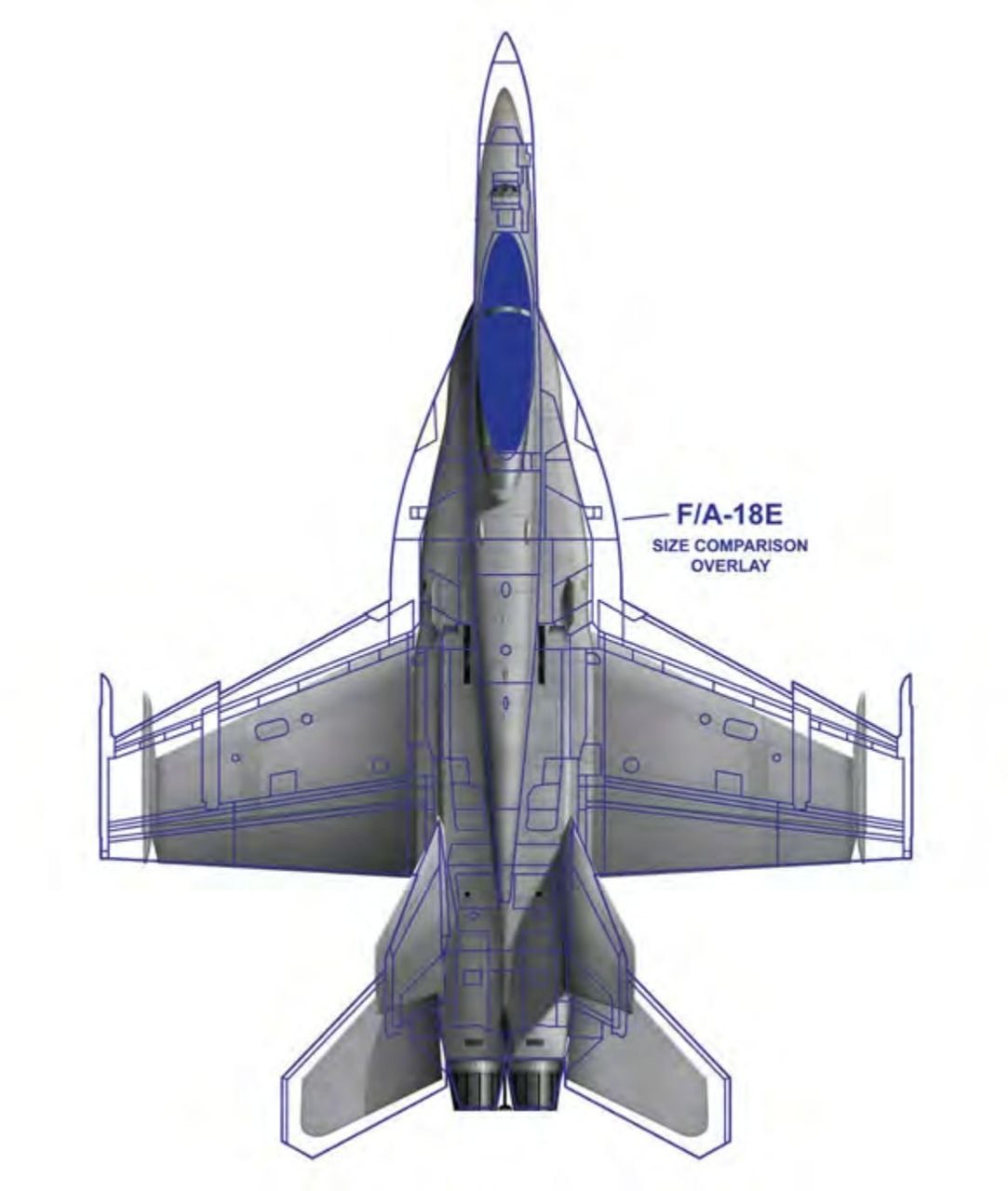
A plan view of a US Navy F/A-18C with the outline of an F/A-18E overlaid for comparison.Andrew Hay/Flying Art
Survivability enhancements made to the Super Hornet included radar-absorbent material in the engine inlets, which were designed to scatter and divert radar beams; serrated edges to access doors and panels; eliminating or filling unnecessary surface gaps and resonant cavities; and replacing grilles covering accessory exhausts and inlets on the airframe with perforated panels.
These features combined to reduce the Super Hornet’s radar cross-section (RCS) by upto 25% over the ‘classic’ Hornet’s depending upon which quadrant it is viewed from.
With a maximum take-off weight of 66,000lb (29,937kg) the Super Hornet is considerably heavier than the Hornet, which weighs in at 51,900lb (23,541kg).
The classic Hornet has nine stations for stores and the Super Hornet 11. The latter’s 34in (86.4cm) fuselage plug meanwhile provides space for nearly 3,600lb (1,633kg) of additional internal fuel.
When external tanks are added, the F/A-18E can carry about 6,600lb (2,994kg) more fuel than the older C-model, while the two-seat F/A-18F’s internal fuel load is around 850lb (386kg) less than the E-model’s. By comparison, the F/A-18C can carry a maximum of 10,860lb (4,926kg) of fuel internally, whereas the F/A-18E can carry 14,400lb (6,532kg).
Depending upon the mission profile, the additional fuel increases the Super Hornet’s range and endurance by as much as 50%, and the jet can remain on station 200nm (370km) from its home carrier for 1.8 hours, 40% longer than the Hornet.
Moreover, its carrier recovery payload is 9,900lb (4,491kg), enabling it to return to the vessel with costly, unexpended weapons. The legacy models are limited to just 5,500lb (2,495kg).
Performance is similar, although the Super Hornet doesn’t require afterburner for carrier launches, and its larger wing reduced approach speed to just 128kts (237km/h) compared to the F/A-18C’s 140kts (259km/h).
Legacy Hornets were originally powered by two General Electric F404-GE-402 low-bypass turbofans, each delivering a maximum thrust of 16,000lb/st (71.17kN). From 1991, F/A-18Cs were delivered with the F404-GE-402 Enhanced Performance Engine (EPE), which improved fuel efficiency and yielded 17,700lb/st (78.73kN) of thrust. The EPE was later retrofitted to the earlier Hornets.
Two 22,000lb/st (97.86kN) General Electric F414-GE-400 turbofans power the Super Hornet. Derived from the F404, this hybrid engine utilised the core of the non-afterburning F412-GE-400 engine – which was originally developed for the cancelled A-12 Avenger II and incorporated design features from the YF120 turbofan under development for the Advanced Tactical Fighter (ATF) programme.
The Hornet’s oval engine intakes were also completely redesigned – the Super Hornet’s rectangular inlets providing 18% more airflow to the more powerful engines.
WEAPONS
The legacy model’s weapons stations can carry up to 14,000lb (6,350kg) of ordnance or external fuel tanks, while the Super Hornet can carry 17,700lb (8,029kg).
The classic and Super Hornets’ weapons capabilities are almost identical – and include the AGM-65 air-to-ground missile, AGM-88 High-Speed Anti-Radiation Missile (HARM), AGM-88E Advanced Anti-Radiation Guided Missile (AARGM), AIM-120 Advanced Medium-Range Air-to-Air Missile (AMRAAM), AGM-154 Joint Stand-Off Weapon (JSOW), GBU-31/32/38 Joint Direct Attack Munition (JDAM), GBU-54 Laser JDAM (LJDAM), GBU-10/12/16/24/51 laser-guided bombs and GBU-12F/52 dual-mode laser-guided bombs.
Both variants can also deliver Mk82/83/84 general-purpose ‘dumb’ bombs, 2.75in (70mm) Hydra rockets and other weapons including cluster bombs and naval mines. They can also launch AGM-84 Harpoon antishipping missiles and the AGM-84K Stand-off Land-Attack Missile-Expanded Response (SLAM-ER).
Wingtip rails support AIM-9 air-to-air missiles, and both classic and Super Hornets feature a nose-mounted internal 20mm M61 rotary cannon. The F/A-18E/F will be capable of delivering the AGM-158C Long Range Air Anti-Ship Missile (LRASM), integration testing of which began in 2015: it’s expected to achieve IOC with the Super Hornet in 2019.
The legacy Hornets can carry up to three 330 US gal (1,249 lit) tanks on the number 5 centreline and wing stations 3 and 7. The Super Hornet features five ‘wet’ stations that can carry up to five 480 US gal (1,817 lit) fuel tanks on the centreline number 6 and wing stations 3, 4, 8 and 9. It can also carry an air refuelling pod (ARP) on the centreline station, enabling it to act as a tanker. The buddyrefuelling store has a fuel capacity of 300 US gal (1,136 lit).
SENSORS
While the F/A-18A had been equipped with the Hughes (now Raytheon) AN/APG- 65 radar, the more capable AN/APG-73 appeared on Lot 16 F/A-18Cs from May 1994 – and on Block I and early production Block II Super Hornets.
Production installation of the Raytheon AN/APG-79 AESA radar was carried out on a number of Lot 27 to 29 aircraft and fully introduced with Lot 30. Boeing unveiled the first AESA radar-equipped fighter in St Louis in April 2005. Its fixed array and agile beam electronically provide for simultaneous airto- air and air-to-ground target detection and tracking.
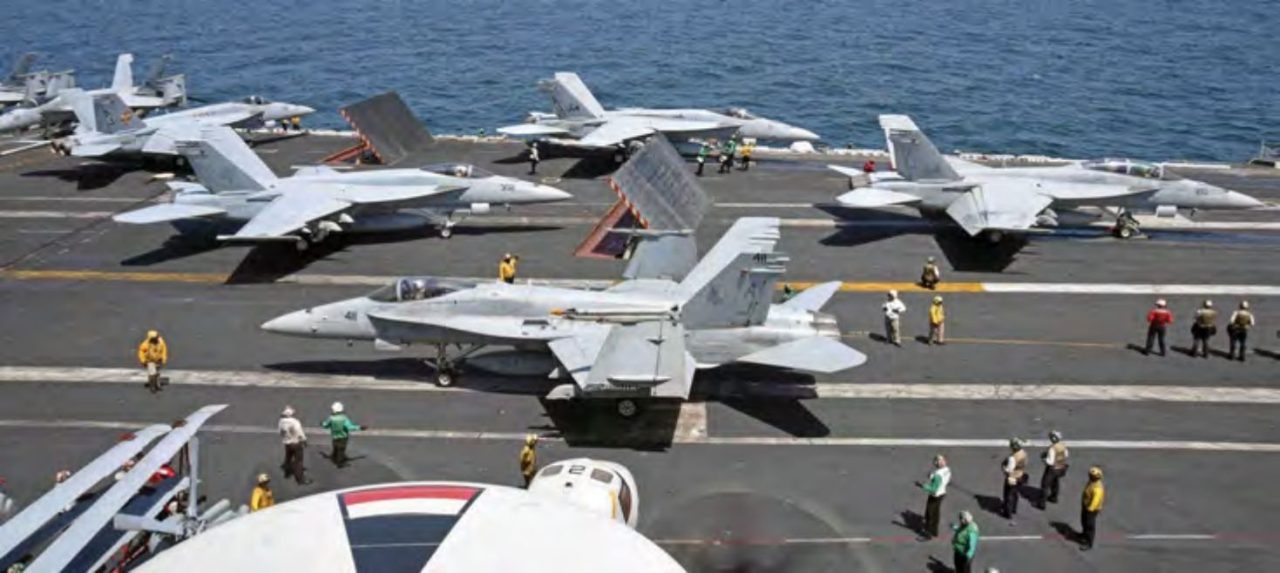 These F/A-18Cs, F/A-18Es and F/A-18Fs from VFA-87, VF-31 and VFA-213 prepare to launch from the USS George H W Bush. Along with the F/A-18E equipped VFA-37, these three squadrons are assigned to carrier air wing CVW-8.US Navy/MC3 Brianna Bowens
These F/A-18Cs, F/A-18Es and F/A-18Fs from VFA-87, VF-31 and VFA-213 prepare to launch from the USS George H W Bush. Along with the F/A-18E equipped VFA-37, these three squadrons are assigned to carrier air wing CVW-8.US Navy/MC3 Brianna Bowens
The AESA, which greatly improved the weapon system’s threat detection range, highresolution synthetic aperture radar ground mapping and targeting capabilities, was later retrofitted to more than 130 earlier Block II airframes and currently equips around 85% of the fleet.
 The Super Hornet can carry 17,700lb (8,029kg) of stores on its 11 weapon stations.US Navy/MC2 Z A Landers
The Super Hornet can carry 17,700lb (8,029kg) of stores on its 11 weapon stations.US Navy/MC2 Z A Landers
The classic Hornet was originally equipped with the AN/AAS-38 Nite Hawk Targeting Forward-Looking Infrared pod (TFLIR) – used in conjunction with the AN/ASQ-173 Laser Spot Tracker/Strike CAMera (LST/SCAM), which was replaced by the AN/AAR-50 Navigation FLIR (NAVFLIR) pod on Night Attack models.
Modifications later provided the AN/AAS- 38 with a Laser Target Designator/Ranger (LTD/R) and an LST for the aircraft to deliver laser-guided munitions autonomously.
Initially equipped with the AN/AAS-46 TFLIR and the AN/AAR-55 NAVFLIR, the Super Hornet introduced the AN/ASQ- 228 Advanced Targeting Forward-Looking Infrared (ATFLIR) pod which combined the functions of the legacy systems into a single unit.
More recently the ATFLIR gained the capability to downlink live video to Remote Operations Video Receiver (ROVER) ground stations, so the aircraft can now support non-traditional intelligence, surveillance and reconnaissance (ISR) and close air support (CAS) missions.
 A ‘Ragin’ Bulls’ F/A-18C is launched from the waist catapult of the USS George H W Bush while conducting ground attacks in support of Operation Inherent Resolve.US Navy/MC3 Christopher Gaines
A ‘Ragin’ Bulls’ F/A-18C is launched from the waist catapult of the USS George H W Bush while conducting ground attacks in support of Operation Inherent Resolve.US Navy/MC3 Christopher Gaines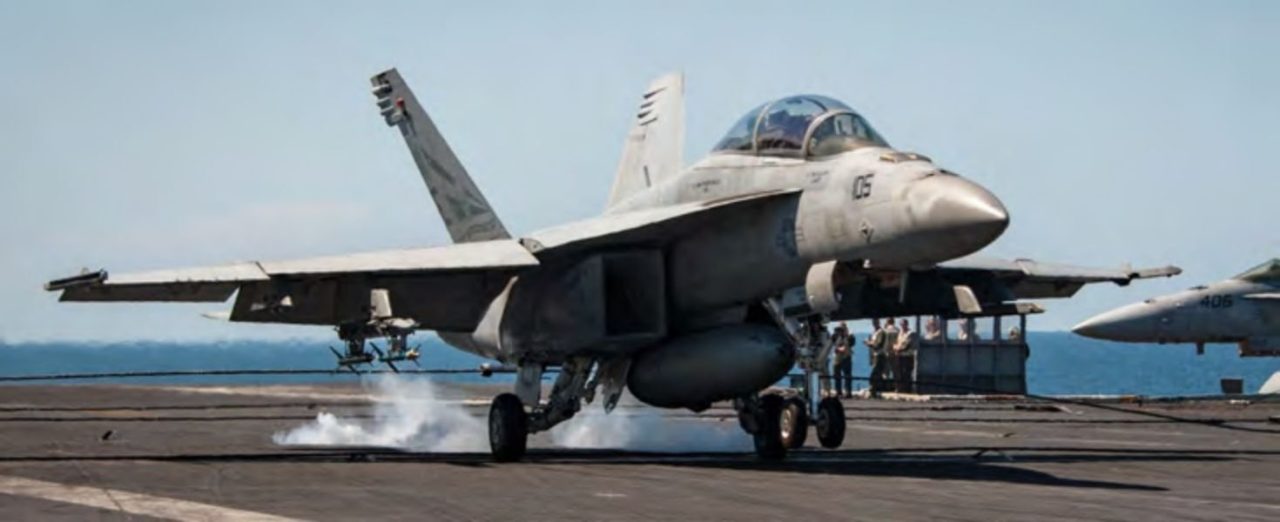 This Block II F/A-18F operated by VFA-2 carries a pair of laser-guided training rounds on a multiple ejector rack (MER).US Navy/Airman Courtney Leavitt
This Block II F/A-18F operated by VFA-2 carries a pair of laser-guided training rounds on a multiple ejector rack (MER).US Navy/Airman Courtney Leavitt
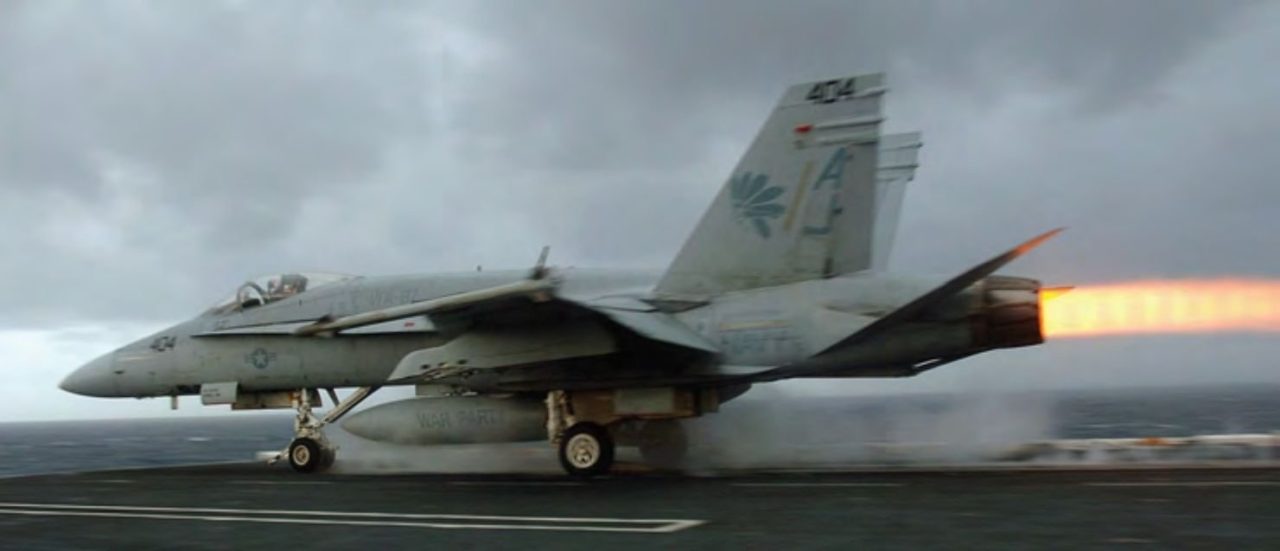 An F/A-18A+ assigned to VFA-87 ‘Golden Warriors’ conducts a full afterburner take-off from the carrier USS Theodore Roosevelt. It is equipped with AIM-9X missiles on the wingtip rails and carries a centreline fuel tank.US Navy/MC2 Michael Cole
An F/A-18A+ assigned to VFA-87 ‘Golden Warriors’ conducts a full afterburner take-off from the carrier USS Theodore Roosevelt. It is equipped with AIM-9X missiles on the wingtip rails and carries a centreline fuel tank.US Navy/MC2 Michael Cole
Although the ATFLIR was integrated with US Navy legacy Hornets, the Marine Corps fighters use AN/AAQ-28 LITENING AT targeting pods, which were first fielded in 2004.
Reconnaissance capable F/A-18D(RC) models, operated by the USMC, can be equipped with the palletised AN/ASD-10 Advanced Tactical Airborne Reconnaissance System (ATARS) that is installed in the nose bay of the aircraft in place of the M61 cannon. The sensor suite consists of a low-altitude electro-optical sensor (LAEO), a medium-altitude electro-optical sensor (MAEO), an infrared line scanner (IRLS), two digital recorders and a pod-mounted datalink. It was first deployed in support of Operation Allied Force in May 1999.
Unlike the US Navy’s legacy Hornets which do not have a reconnaissance capability, the Super Hornet is compatible with the Raytheon AN/ASD-12 Shared Reconnaissance Pod (SHARP). First deployed in 2003 this high resolution, digital tactical air reconnaissance system features advanced day/night and all-weather capability.
Carried on the centreline station, the high resolution, multi-sensor pod provides near real-time dual-band electro-optical/infrared (EO/IR) medium- and high-altitude standoff imagery.
When the Super Hornet entered production, its avionics systems shared around 90% commonality with the F/A-18C. Changes to the cockpit incorporated a new colour multifunction display (MFD), an engine/ fuel display and a monochrome Up-Front Control Display (UFCD). It was also equipped with the AN/USQ-140 Multifunctional Information Distribution System (MIDS) for Link 16 jam-resistant, secure digital voice and data communications.
The Super Hornet was the first naval fighter to receive the Joint Helmet Mounted Cueing System (JHMCS), which provides multi-purpose aircrew situational awareness, including high-off-boresight cueing of the AIM- 9X air-to-air missile. MIDS and JHMCS have both since been integrated with the legacy Hornet.
Although the USN fielded two-seat F/A-18Fs to operational squadrons, like the earlier F/A-18B/D, it was originally intended as a trainer and the aft cockpit of the Block I versions replicated the systems installed in the front. Apart from those ‘F’ models used for pilot training, the two-seaters, like the USMC F/A-18Ds, cannot be flown from the aft cockpit and the control stick and throttles are replaced by two HCUs.
Block II Super Hornets were equipped with a digital video map computer, advanced mission computers and displays (AMC&D) upgrades, and the rear cockpit of the F/A-18F gained an Advanced Crew Station (ACS) that featured a large 8 x 10in (20.3 x 25.4cm) aft seat multi-purpose display (AMPD) as well as two 5 x 5in (12.7 x 12.7cm) colour advanced multi-purpose displays (AMPDs) and two new HCUs. Incorporation of the AESA radar allowed the front and redesigned aft cockpits to be decoupled. This capability enables the pilot and WSO to independently conduct air-to toair and air-to-ground functions simultaneously. A subsequent upgrade incorporated the Distributed Targeting System (DTS) so the aircraft can hit moving ground targets.
Block I Super Hornets were equipped with the AN/ALR-67 radar warning receiver (RWR), AN/ALE-47 countermeasures dispenser system (CDS) and an Integrated Defensive Countermeasures (IDECM) system comprising the AN/ALQ-165 Airborne Self- Protection Jammer (ASPJ) and the AN/ALE- 50 RF towed countermeasures decoy. The Block II’s IDECM systems were replaced with the AN/ALQ-214 Onboard Jammer (OBJ) and AN/ALE-55 fibre optic towed decoy.
Although the legacy Hornet’s defensive systems include the AN/ALQ-126 Defensive Electronic Countermeasures (DECM) suite, it will be replaced by a variant of the ALQ-214. Additionally, the jets are being retrofitted with the latest version of the ALR-67.
UPGRADES
The F/A-18 fleet is monitored thorough the Service Life Management Programme (SLMP) and analysis is conducted under the Service Life Assessment Programme (SLAP).
Structural modifications extend the Hornets’ service life to 8,000 hours and a Service Life Extension Programme (SLEP) will see 150 ‘hand-selected’ F/A-18C/Ds fly 10,000 hours. The first Hornets to undergo SLEP were delivered in 2016. A similar programme will extend the Super Hornet’s service life from 6,000 to 9,000 hours.
As part of a plan to keep the F/A-18A operationally relevant, the US Navy modified 61 aircraft to the A+ configuration, with upgraded APG-65 or AN/APG-73 radar and avionics. Subsequently 54 F/A-18A+ aircraft were upgraded to an equivalent F/A-18C capability under the designation F/A-18A++.
Another plan to bring 30 low-time, early production F/A-18Cs to a C+ configuration for the Marines will be completed in 2019. This will provide digital communications, MIDS, Link 16 data link, colour cockpit displays, Tactical Aircraft Moving Map Capability (TAMMAC), AN/ALE-47, the SJU-17 Naval Aircrew Common Ejection Seat (NACES) and the JHMCS along with the ability to carry the latest G4 version of the AN/AAQ-28 targeting pod. Boeing delivered the first upgraded F/A- 18C+ models in 2016.
Early this year, the US Navy had a fleet of 36 F/A-18As, 14 F/A-18Bs, 219 F/A-18Cs and 35 F/A-18Ds and 287 F/A-18Es and 259 F/A-18Fs. The Marine Corps had 53 F/A- 18As, seven F/A-18Bs, 129 F/A-18Cs and 92 F/A-18Ds.
The last F/A-18C flight was carried out by VFA-113 at NAS Lemoore, California, in February 2016, and all the Pacific Fleet squadrons have since transitioned to the Super Hornet, leaving Hornets with four Atlantic Fleet, three test, two Naval Reserve units as well as the US Naval Air Test Pilot School, Naval Air Warfare Development Center and the US Navy Flight Demonstration Squadron ‘Blue Angels’.
Under current plans, legacy Hornets will continue in service with operational and reserve squadrons until 2027 and 2034 respectively. The navy’s latest Programme of Record calls for 662 Super Hornets, comprising 344 F/A-18Es and 318 F/A-18Fs, and the fighters will likely remain in service until 2040 or later.
The 2017 Defense Authorization Act provided for the purchase of 26 Super Hornets, and for FY2018 the USN requested 14 aircraft. As part of a plan to increase the size and capability of its strike fighter fleet, the USN intends to acquire at least 80 additional F/A- 18E/Fs over the next five years at a cost of $7.1bn, and believes that replacing its remaining F/A-18C/Ds will save about $290m by not upgrading and maintaining the legacy fighters.
Opting to retain their legacy Hornets until replaced by F-35B/C Joint Strike Fighters, the Marines did not acquire Super Hornets. As noted in the 2017 Marine Aviation Plan, its jets will remain in service with the active duty squadrons until FY2030 and with the reserves until FY2031, and the former will be consolidated at MCAS Miramar, California, in 2027.
Continued upgrades will provide the Hornet with an Advanced Capabilities Mission Computer (ACMC) plus new displays – and weapons including AIM-120D and AIM-9X Block II missiles, the Joint Direct Attack Munition-Extended Range (JDAM-ER), 2.75in (70mm) laser-guided advanced precision kill weapon system (APKWS) rockets and the GBU-53 Small Diameter Bomb II (SDB II).
 A two-seat Block II F/A-18F assigned to VFA-213 ‘Black Lions’, prepares to make an arrested landing aboard the USS George H W Bush in the Persian Gulf.US Navy/MC3 Christopher Gaines
A two-seat Block II F/A-18F assigned to VFA-213 ‘Black Lions’, prepares to make an arrested landing aboard the USS George H W Bush in the Persian Gulf.US Navy/MC3 Christopher Gaines
 A dual-control F/A-18D assigned to VFA-106 ‘Gladiators’ makes an arrested landing aboard the carrier USS Harry S Truman. This squadron is responsible for all US Navy legacy Hornet training.US Navy/PHOM2 Aldon L Taylor
A dual-control F/A-18D assigned to VFA-106 ‘Gladiators’ makes an arrested landing aboard the carrier USS Harry S Truman. This squadron is responsible for all US Navy legacy Hornet training.US Navy/PHOM2 Aldon L Taylor
The USN’s Super Hornet modernisation plan is taking an incremental approach to incorporate new technologies and capabilities, which include Digital Communication System Radios, MIDS-JTRS (Joint Tactical Radio System), upgraded ATFLIR, Accurate Navigation (ANAV), integrated infrared search and track (IRST) and radar upgrades.
Future plans envisage integrating the AIM-120D, upgrading the AIM-9X missiles and improving the cockpit and displays. Several of the upgrades – which will combine to make the Super Hornet a ‘smart node’ in the navy’s Integrated Fire Control Counter-Air (NIFC-CA) network – were featured in Boeing’s proposed Advanced Super Hornet and later Block III upgrade.
According to the manufacturer, Block III is “a balanced approach to survivability, including electronic warfare and self-protection”, which it says it could begin delivering in late 2020.
Fielding of an IRST sensor first tested in 2014 will begin in 2017: considered to be an interim solution, the AN/ASG-34 will enable the fighter to detect aerial targets passively at long ranges.
Installed in the front of an FPU-13 fuel tank assembly and carried on the centreline station, it will offer an alternative fire control system in a high-electronic attack/radar-denied environment. Boeing received an $89m contract to integrate a Block II IRST system with the F/A-18E/F in May this year.
The USN’s FY2018 budget request revealed plans for investing $265m over five years to upgrade the Super Hornet fleet to the Block III configuration, beginning in 2019.
The work will integrate advanced network architecture, cockpit displays – including a large area 10 x 19in (25.4 x 48.3cm) display – a more powerful Distributed Targeting Processing Network (DTPN) computer and a Tactical Targeting Network Technology (TTNT) data link. The latter will see the Super Hornet, EA-18G Growler and E-2D Hawkeye sharing data over a common network in combat.
In addition, conformal fuel tanks (CFTs) will replace the fighter’s external tanks. First offered as part of Boeing’s Advanced Super Hornet, the CFTs – which will hold 3,500 US gal (13,249 lit) – will extend range by between 110 and 120nm (185 and 222km), reduce drag and allow for additional stores to be carried under the wings.
The fighter’s RCS will meanwhile be further reduced by the inclusion of “advanced signature enhancements”. Overall, Block III will see the Super Hornet complement the F-35C rather than replacing it as suggested by President Trump earlier this year.
Elected officials recently voiced concerns over the ability of Naval Reserve’s F/A-18A+ aircraft to meet operational requirements, recommending that the USN consider replacing the aircraft. Although the legacy Hornets are scheduled to remain in service for at least another decade, continued procurement of Super Hornets could potentially hasten their retirement.
 An F/A-18E assigned to VFA-195 in formation with a pair of F-4EJ Kais from the Japan Air Self-Defense Force’s 302nd Tactical Fighter Squadron during a dissimilar air combat training mission.
An F/A-18E assigned to VFA-195 in formation with a pair of F-4EJ Kais from the Japan Air Self-Defense Force’s 302nd Tactical Fighter Squadron during a dissimilar air combat training mission.
Source: key.aero
